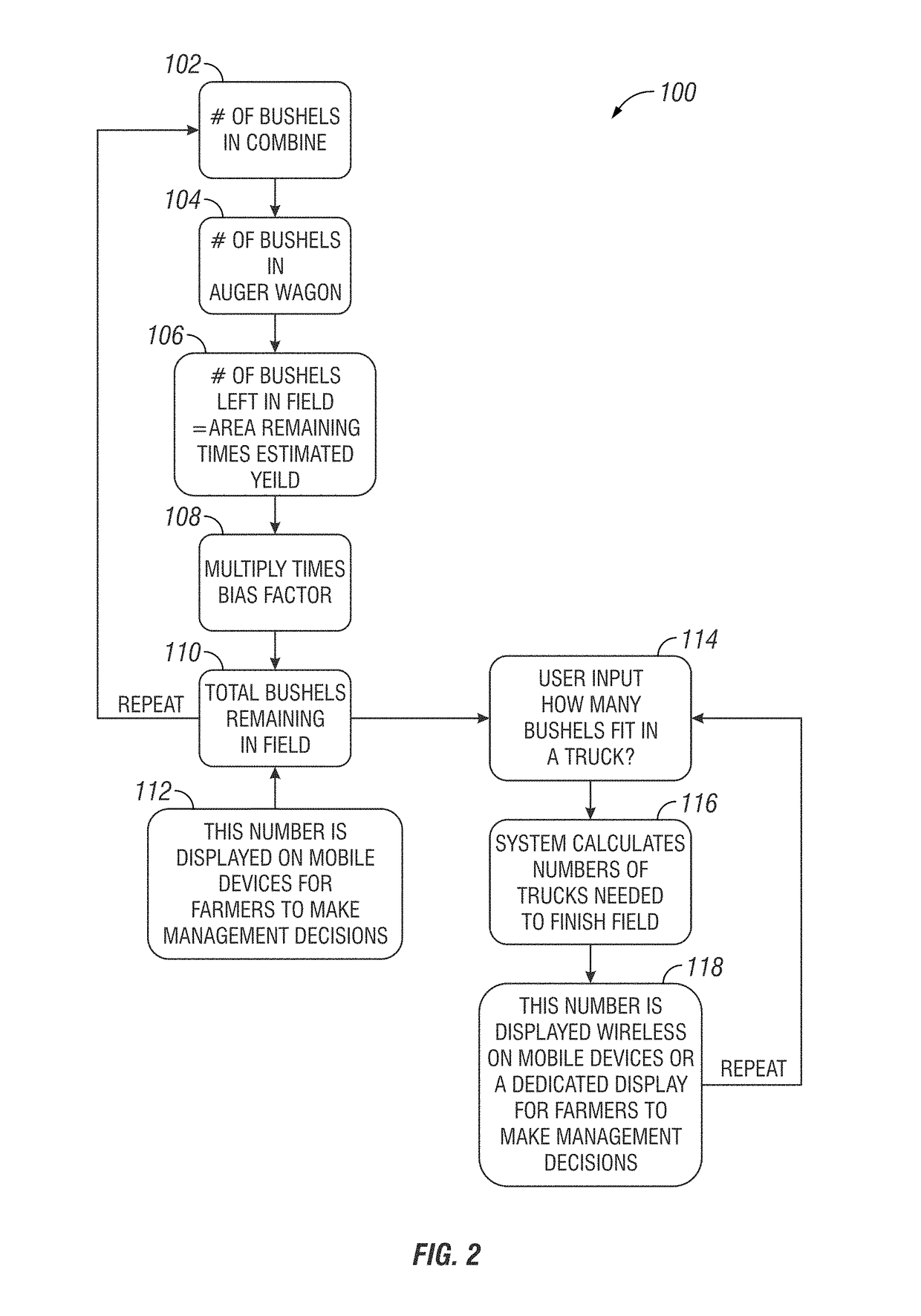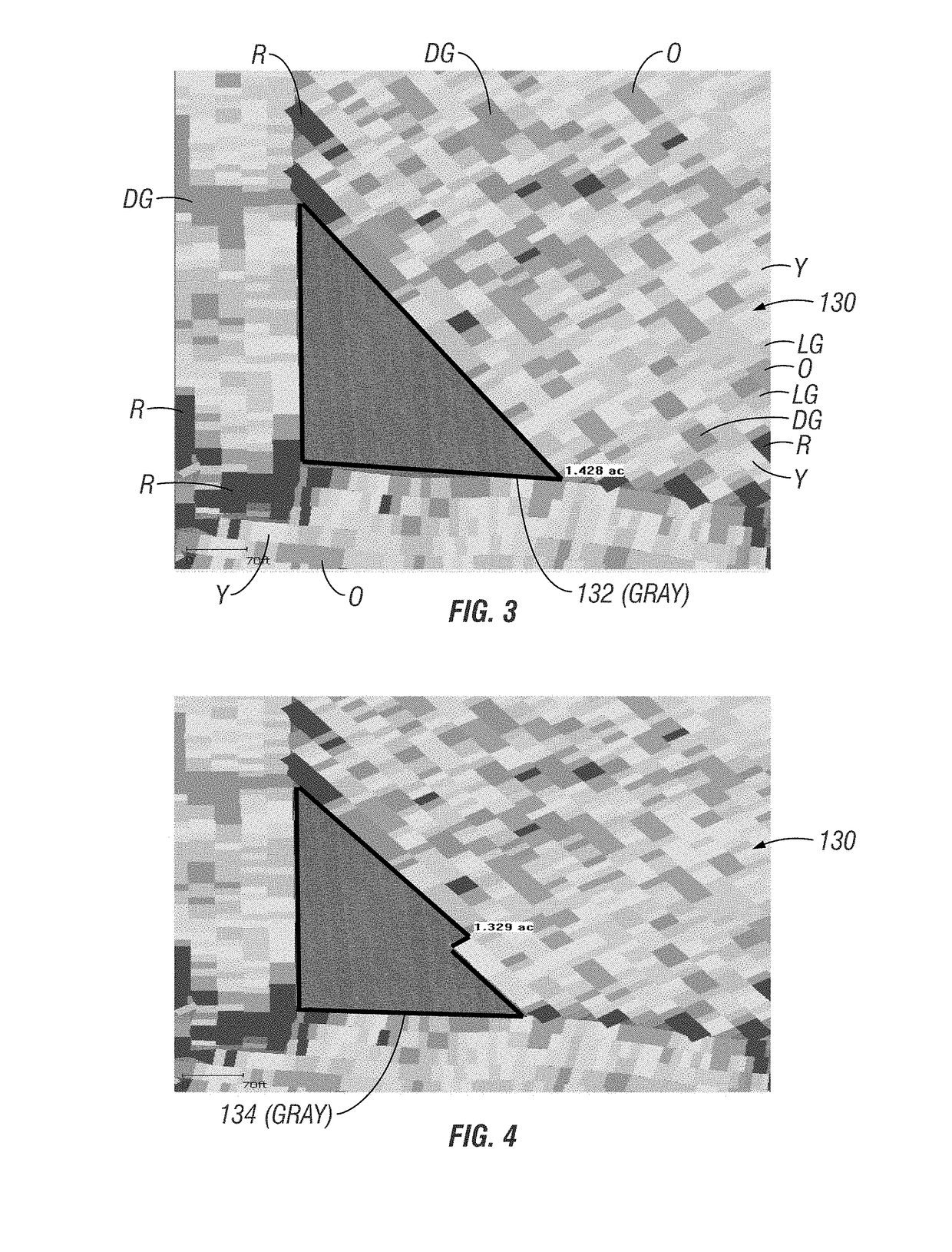Prediction of amount of crop or product remaining for field
a technology of crop or product and field, applied in the field of agriculture technology, can solve the problems of increasing the complexity of harvest operations, not being able to communicate or even determine information, and increasing problems, so as to improve logistics operations, reduce vehicle traffic, and improve management decisions.
- Summary
- Abstract
- Description
- Claims
- Application Information
AI Technical Summary
Benefits of technology
Problems solved by technology
Method used
Image
Examples
example 1
D. Example 1
[0036]FIG. 3 illustrates by aerial plan view a field 130 digitally represented on a monitor display with an unharvested area 132 graphically indicated on the display. Based on the geometry and dimensions of the unharvested area the area 132 can be calculated. This can be done by the monitor system by programming and using inputs values such as previously harvested / applied area, swath width, speed, and GPS location. By using this data the system in real time can precisely calculate the area remaining every few seconds. The resolution, accuracy, and precision of the unharvested area can be within the resolution, accuracy, and precision of the technique used to identify the unharvested area. But cruder estimates of area 132 can be made and utilized. For example, if appropriately programming, the person at the display might be able to draw an outline (e.g. by touchscreen drawing tools) of the unharvested portion of the field displayed, as a rougher estimate of that area. The...
example 2
E. Example 2
[0042]FIG. 5 illustrates a yield map 138 for a field (again a digital representation in aerial plan view on a digital display). There are various areas within the field having different yields in a given harvest year (the boundaries of which can indicated by visually or otherwise distinguishable graphics on the display). This includes areas 140, 142, and 144. Area 140 is a portion of the field which has not been harvested yet. Note, in this example, that area 142 has been determined (e.g. by a yield monitor) to have a yield of 150 bushels per acre and area 144 has a yield of 220 bushels per acre. In FIGS. 5-7, yield ranges are color-coded as follows: Dark green (G) highest (including 220 bu / ac); light green (LG) next highest; orange (O) next highest (including 185 bu / ac); yellow (Y) next highest; dark red (R) next highest (including 150 bu / ac). As can be seen, areas of like yields are more amorphous than FIGS. 3 and 4, but tend to occupy more contiguous sub-areas. For ex...
example 3
F. Example 3
[0044]FIG. 8 and FIG. 9 illustrate a yield scenario for a different field 160. In FIG. 8 there is displayed an area to be harvested 166, with areas 162 and 164 on either side. Both area 162 and 164 show low yields (color coding is the same as FIGS. 3-7; (R) indicates red or low yield average of 150 bu / ac; orange (O) and yellow (Y) indicate higher yield, and light green (LG) and green (G) indicate highest. FIG. 9 illustrates the same field in a previous year where yield of area 166 is known. Here, areas 162 and 164 show low yields (150 bushes / acre or color (R)), but area 166 shows a relatively high yield (240 bushels / acre or color (G)).
[0045]Thus the field scenario shown in FIGS. 5-7 and FIG. 8-9 demonstrate how using previous yield data and other parameters can further help predict the yield that is remaining in certain areas of the field and avoid mistakes in estimating or predicting yield. By not only utilizing present year yield measurements of the harvested portion o...
PUM
 Login to View More
Login to View More Abstract
Description
Claims
Application Information
 Login to View More
Login to View More - R&D
- Intellectual Property
- Life Sciences
- Materials
- Tech Scout
- Unparalleled Data Quality
- Higher Quality Content
- 60% Fewer Hallucinations
Browse by: Latest US Patents, China's latest patents, Technical Efficacy Thesaurus, Application Domain, Technology Topic, Popular Technical Reports.
© 2025 PatSnap. All rights reserved.Legal|Privacy policy|Modern Slavery Act Transparency Statement|Sitemap|About US| Contact US: help@patsnap.com



